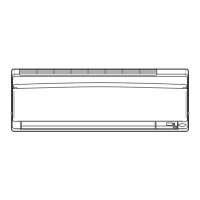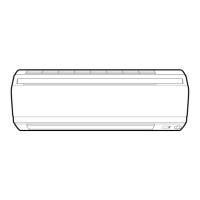
Do you have a question about the Daikin FTXS25K3V1B and is the answer not in the manual?
| Cooling Capacity | 2.5 kW |
|---|---|
| Heating Capacity | 3.2 kW |
| Energy Efficiency Ratio (EER) | 3.21 |
| Seasonal Energy Efficiency Ratio (SEER) | 6.10 |
| Power Supply | 220-240V, 50Hz |
| Refrigerant | R32 |
| Weight (Indoor Unit) | 9 kg |
| Indoor Unit Weight | 9 kg |
| Type | Split System |
| Noise Level (Indoor Unit) | 19 dB |
Detects human movement for automatic energy-saving operation when the room is empty.
Allows saving up to 4 timer settings daily for customized on/off times and temperatures.
Directs airflow upward in COOL and downward in HEAT to avoid direct contact with occupants.
Lowers the noise level of the outdoor unit, useful for considering neighborhood noise.
Important safety information classified as WARNING and CAUTION for proper unit operation and user safety.
Guidelines for choosing an installation site considering environment, noise, and drainage.
Specifies the need for a dedicated power circuit for the air conditioner's power supply.
Advises consulting a dealer for specialized knowledge required for relocating the air conditioner.
Identifies and describes major parts of the indoor unit, including sensors and controls.
Details the air filter and titanium apatite photocatalytic air-purifying filter for the indoor unit.
Identifies key external components of the outdoor unit, including inlets, outlets, and terminals.
Identifies and explains the function of various parts of the remote controller, including display and buttons.
Explains the function of each button on the remote controller for various operations.
Instructions for setting batteries in the remote controller and mounting its holder on the wall.
Step-by-step guide to set the indoor unit's internal clock for accurate timer operations.
Instructions on how to select and start different operation modes (AUTO, DRY, COOL, HEAT, FAN).
Instructions on how to stop the air conditioner's operation.
Guide on how to adjust the temperature setting using the remote controller.
Provides recommended temperature settings and energy-saving tips for optimal performance.
How to activate and control the automatic swing function for airflow direction.
Instructions on manually adjusting the vertical louvers for precise airflow direction.
How to select different fan speeds (Auto, Low, Middle, High) for airflow.
Details flap swinging ranges and provides a caution regarding manual adjustment.
Explains how to start the COMFORT AIRFLOW operation for improved comfort.
Instructions on how to cancel the COMFORT AIRFLOW operation and return to previous settings.
How to enable the Intelligent Eye sensor for energy-saving operation based on room occupancy.
Instructions on how to disable the Intelligent Eye sensor.
Details how the Intelligent Eye sensor functions for energy saving, including temperature shifts.
Provides application range, limitations, and cautions for the Intelligent Eye sensor.
How to initiate the POWERFUL operation for maximum cooling or heating effect.
Instructions on how to stop the POWERFUL operation and return to normal settings.
How to activate the OUTDOOR UNIT QUIET operation to reduce noise levels.
Instructions on how to deactivate the OUTDOOR UNIT QUIET operation.
How to start the ECONO operation to limit maximum power consumption for efficient use.
Instructions on how to stop the ECONO operation.
Guide to setting and canceling the OFF TIMER for automatic shutdown.
Explains the NIGHT SET mode's temperature adjustment during OFF TIMER for comfortable sleep.
Guide to setting and canceling the ON TIMER for automatic startup.
Shows how to combine ON and OFF timer settings for complex scheduling.
Provides an example of setting weekly timer schedules for weekdays and weekends.
Step-by-step guide to set the day, time, and temperature for the WEEKLY TIMER.
Instructions for setting the specific time and temperature for WEEKLY TIMER reservations.
How to copy timer settings from one day to another for easier programming.
How to confirm active reservations and deactivate the WEEKLY TIMER operation.
Instructions on how to delete individual, daily, or all reservations from the WEEKLY TIMER.
Explains how to select operation modes in a multi-system setup, considering priority rooms.
Details priority room settings and COOL/HEAT mode lock features for multi-system units.
Instructions for cleaning the front panel, air filters, and other unit parts.
Detailed steps for removing, cleaning, and reattaching the front panel of the indoor unit.
Instructions on how to pull out, wash, and replace the air filters.
Steps for cleaning or replacing the titanium apatite photocatalytic air-purifying filter.
Guidance on checking units, preparing for long idle periods, and periodical maintenance.
Provides details about the refrigerant type and its environmental impact.
Explains common sounds and operation delays that are not actual troubles.
Addresses issues like no operation, poor effect, sudden stops, abnormal functioning, and mist.
Covers issues like delayed heat, fan rotation, timer faults, odors, remote control problems, and mode selection.
Lists critical issues requiring immediate service and provides disposal requirements for the unit.
How to access and interpret error codes displayed on the remote controller for system faults.
Explains the meaning of LED indicator patterns on outdoor unit PCBs for fault diagnosis.
A visual summary of operation modes, airflow directions, and temperature settings.











